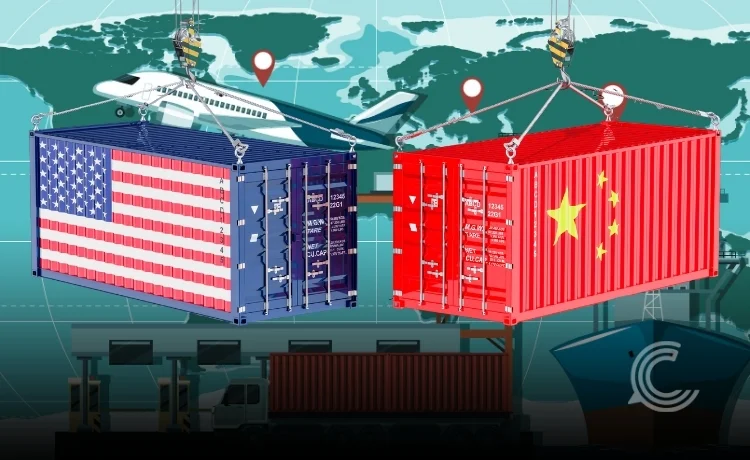Tariff rollercoaster prompts Chinese exporters to ‘give up’ on US as traders shift to Europe, Latin America

Key Highlights–
- Chinese manufacturers are shifting away from American buyers amid policy whiplash.
- Emerging markets benefit: Europe, Latin America, and Africa see rising Chinese exports as companies diversify.
- Rare-earth tensions escalate trade risks as the US threatens 100% tariffs in response to China’s export controls.
A wave of chaotic and aggressive tariff threats from the United States has driven a significant portion of China’s export-oriented manufacturing sector to abandon the American market. Exporters, ranging from small factory owners making kitchen appliances to large companies producing seasonal decorations, are reporting “extreme exhaustion” from the unpredictability of US trade policy.
The tariff rollercoaster of hikes, de-escalations, and the recent threat of an additional triple-digit tariff increase from US President Donald Trump has forced a rapid reorientation of global trade routes. Chinese firms are now aggressively chasing new customers across Europe, Latin America, the Middle East, and Africa.
The Unstable US Market
For many manufacturers, the American market is now deemed too unreliable. Jacky Ren, who runs Gstar Electronics Appliance, confirmed he has “given up” on the US. His factory once drew over 60% of its income from American orders. He describes the regulatory environment as impossible to navigate, citing the “tit-for-tat tariff escalations” that define the current relationship between Washington and Beijing.
Also Read | Donald Trump Threatens Tariffs on Spain Over NATO Defense Spending Standoff
The latest friction point is a trade stand-off over China’s new curbs on rare earths exports, which the US answered with a threat of tariffs exceeding 100%.3 One overseas sales manager at a Chinese firm, Cherry Yuan, summed up the sentiment: “The situation’s too unstable. [Trump’s] like a child—crying one minute, laughing the next. You can’t play along with that.”
Crowded Escape Routes
Despite the pain of losing US customers, China’s total exports show resilience. Chinese customs data released this week confirms the pivot is well underway. The world’s second-largest economy saw its total exports grow by 7.1% to 19.95 trillion yuan ($2.80 trillion) in the first nine months of this year. This growth is recorded despite a notable slump in goods shipped directly to the US.4
The redirection of trade is evident at major events. At the autumn Canton Fair in Guangzhou, the world’s largest trade show, a survey of 15 companies by reporters revealed zero attendance from US buyers. Instead, manufacturers reported a sharp rise in attendees from Brazil, Southeast Asia, and Europe. Indicating that the trade diversion is a comprehensive, structural shift and not a temporary measure.
Dramatic Drop in Profitability
While the overall export volume remains strong, Chinese exporters are not celebrating. The simultaneous pivot by thousands of Chinese manufacturers into new markets has led to fierce competition, crushing profitability.
Lou Xiaobo, a manufacturer of Halloween decorations, is currently in Brazil for market research. According to Reuters, his company’s “order volume and revenue have plummeted by half.” This is because global demand from these new markets is simply “not enough to replace U.S. demand.” Exporters are increasingly forced to sell goods at a loss just to hold onto market share.
Retaliation and Rare Earths
The trade war’s latest escalation was triggered by China. Beijing imposed sweeping new controls on its exports of rare earth elements, materials vital for US defence, electric vehicles (EVs), and high-tech manufacturing. China dominates the processing of these minerals.
In response, Trump issued a threat of an additional 100% tariff on Chinese goods. China’s Ministry of Commerce condemned the move as a “classic case of ‘double standards.'” Beijing maintains it does not “want to fight, but is not afraid to fight.” The Chinese government asserts its rare earth curbs are for national security, not trade war tactics. Additionally, signaling that tensions remain explosive, endangering a planned meeting between the two nations’ leaders.
Trade War Shifts Economy
Economists warn that if the proposed 100% tariff hike takes effect, the cumulative duty would be potentially 140%, effectively “shutting down trade” between the two nations, as reported by leading news agencies.
Furthermore, forcing China to strengthen its trade with the European Union, the Association of Southeast Asian Nations (ASEAN), and African nations.
Exporters have no choice but to hold on and wait for an opportunity, as the focus is survival in a fiercely competitive global landscape outside of the once-dominant US market.



